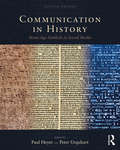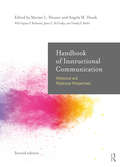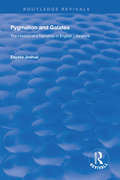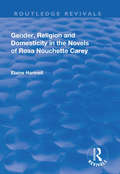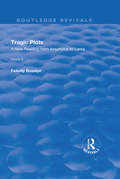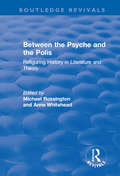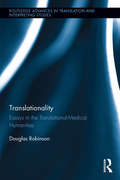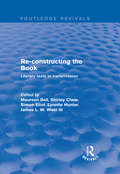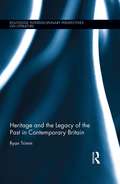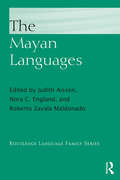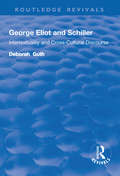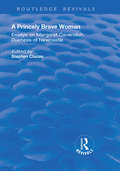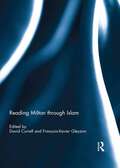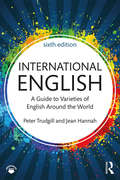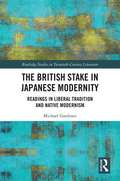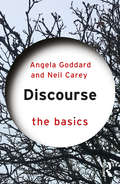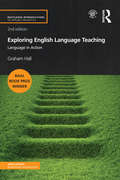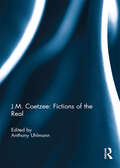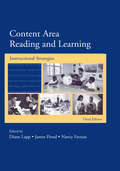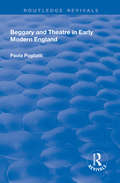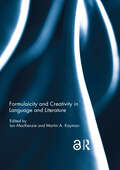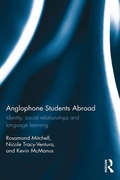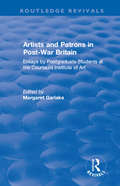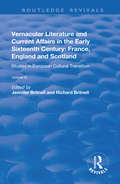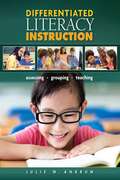- Table View
- List View
Communication in History: Stone-Age Symbols to Social Media (Seventh Edition)
by David Crowley Peter Urquhart Paul HeyerNow in its 7th edition, Communication in History reveals how media has been influential in both maintaining social order and as powerful agents of change. Thirty-eight contributions from a wide range of voices offer instructors the opportunity to customize their courses while challenging students to build upon their own knowledge and skill sets. From stone-age symbols and early writing to the Internet and social media, readers are introduced to an expansive, intellectually enlivening study of the relationship between human history and communication media.
Handbook of Instructional Communication: Rhetorical and Relational Perspectives
by Marian L. Houser Angela HosekThe Handbook of Instructional Communication offers a comprehensive collection of theory and research focusing on the role and effects of communication in instructional environments. Now in its Second Edition, the handbook covers an up-to-date array of topics that includes social identity, technology, and civility and dissent. This volume demonstrates how to understand, plan, and conduct instructional communication research as well as consult with scholars across the communication discipline. Designed to address the challenges facing educators in traditional and nontraditional settings, this edition features a wealth of in-text resources, including directions for future research, suggested readings, and surveys for instructional assessment.
Pygmalion and Galatea: The History of a Narrative in English Literature
by Essaka JoshuaThis title was published in 2001. Pygmalion and Galatea presents an account of the development of the Pygmalion story from its origins in early Greek myth until the twentieth century. It focuses on the use of the story in nineteenth-century British literature, exploring gender issues, the nature of artistic creativity and the morality of Greek art.
Gender, Religion and Domesticity in the Novels of Rosa Nouchette Carey
by Elaine HartnellThis title was first published in 2000. Rosa Nouchette Carey (1840-1909), the English author of forty-one ’domestic’ novels, was continuously in print from 1868 until at least 1924 and yet she is virtually unknown today. This first in-depth study of Carey’s work assesses both her immense popularity and her subsequent fall from favour. Organized thematically, it engages with the historical and cultural context of the novels as well as comparing them with the work of Carey’s contemporaries. Matters such as Carey’s creative response towards spinsterhood, her provision of vicarious male approval and her valorization of housework are perceived as functions of her writing that lie beyond formal literary criticism. This is not to deny the literary value of Carey’s work; rather it is to make intelligible its value to a large and enthusiastic readership despite an undoubted lack of appreciation on the part of reviewers.
Tragic Plots: A New Reading from Aeschylus to Lorca (Routledge Revivals Ser. #Vol. 9)
by Felicity RosslynThis title was first published in 2000. This book offers a wide-ranging account of tragic drama from the Greeks to Arthur Miller. It puts forward a bold and vigorously developed argument about the recurrent concerns of tragedy, and proposes to uncover the archetypal tragic plot that emerges at key points of historical transition. It traces this plot through fascinatingly diverse formations on Athens, Renaissance England and the modern world, and offers detailed analysis of over twenty plays. The needs of the first-time reader are not forgotten, while challenging new light is thrown on each period. There is substantial discussion of Aeschylus, Sophocles, Euripedes, Marlowe, Shakespeare, Ibsen, Strindberg, Chekhov, Lorca and Miller, along with briefer consideration of the Senecan tradition, Yeats, Synge, O’Neill and T.S. Eliot. Felicity Rosslyn asks why tragic plays get written when they do, and why they so often dramatise the struggle to break the ties of blood for the bonds of law.
Between the Psyche and the Polis: Refiguring History in Literature and Theory (Routledge Revivals Ser.)
by Anne WhiteheadThis title was first published in 2000. Incorporating studies of Freudian and Marxist approaches to questions of history and memory, this timely collection illuminates how history is being refigured in contemporary literary, cultural and theoretical studies. The contributors to this volume invite the reader to attend to the forms - linguistic, visual, monumental - by which a connection with, or separation from, the past takes place. It is current thinking about memory's relationship to history, and the ongoing critical reassessment of historicism, that preoccupies this collection. The volume explores the ways in which current thinking about the past operates within a dialogic space and can be located in relation to multiple perspectives. Thus cultural memory can be seen not just as a recent development within the field of cultural studies, but as constructing a between-space which also draws in aspects of psychoanalysis. Similarly, trauma theory may usefully be conceptualized as operating in a rich and complex dynamic between deconstruction and the work of Freud. Temporality, memory and the past are attended to here in terms of the dislocations of narrative, of resistances to linear genealogies, to aid the reader in making unanticipated connections between theories and cultures, and between the demands of the psyche and the polis.
Translationality: Essays in the Translational-Medical Humanities (Routledge Advances in Translation and Interpreting Studies)
by Douglas RobinsonThis book defines "translationality" by weaving a number of sub- and interdisciplinary interests through the medical humanities: medicine in literature, the translational history of medical literature, a medical (neuroscience) approach to literary translation and translational hermeneutics, and a humanities (phenomenological/performative) approach to translational medicine. It consists of three long essays: the first on the traditional medicine-in-literature side of the medical humanities, with a close look at a recent novel built around the Capgras delusion and other neurological misidentification disorders; the second beginning with the traditional history-of-medicine side of the medical humanities, but segueing into literary history, translation history, and translation theory; the third on the social neuroscience of translational hermeneutics. The conclusion links the discussion up with a humanistic (performative/phenomenological) take on translational medicine.
Re-Constructing the Book: Literary Texts in Transmission
by Simon Eliot Shirley Chew Maureen BellThis title was first published in 2001. Literary critics, textual editors and bibliographers, and historians of publishing have hitherto tended to publish their research as if in separate fields of enquiry. The purpose of this volume is to bring together contributions from these fields in a dialogue rooted in the transmission of texts. Arranged chronologically, so as to allow the use of individual sections relevant to period literature courses, the book offers students and teachers a set of essays designed to reflect these approaches and to signal their potential for fruitful integration. Some of the essays answer the demand "Show me what literary critics (or textual editor; or book historians) do and how they do it", and stand as examples of the different concerns, methodologies and strategies employed. Others draw attention to the potential of the approaches in combination.
Heritage and the Legacy of the Past in Contemporary Britain (Routledge Interdisciplinary Perspectives on Literature)
by Ryan TrimmBringing together heritage studies and literary studies, this book examines heritage as a ubiquitous trope in contemporary Britain, a seemingly inescapable figure for relations to the past. Inheritance has been an important metaphor for characterizing cultural and political traditions since the 1970s, but one criticized for its conservatism and apparent disinheritance of "new" Britons. Engaging with contemporary literary and cinematic texts, the book interrogates metaphoric resonances: that bestowing past, receiving present, and transmitted bounty are all singular and unified; that transmission between past and present is smooth, despite heritage depending on death; that the past enjoins the present to conserve its legacy into the future. However, heritage offers an alternative to modern market-driven relations, transactions stressing connection only through a momentary exchange, for bequest resembles gift-giving and connects past to present. Consequently, heritage contains competing impulses, subtexts largely unexplored given the trope’s lapse into cliché. The volume charts how these resonances developed, as well as charting more contemporary aspects of heritage: as postmodern image, tourist industry, historic environment, and metaculture. These dimensions develop the trope, moving it from singular focus on continuity with the past to one more oriented around different lines of relation between past, present, and future. Heritage as a trope is explored through a wide range of texts: core accounts of political theory (Locke and Burke); seminal documents within historic conservation; phenomenology and poststructuralism; film and television (Merchant-Ivory, Downton Abbey); and a broad range of contemporary fiction from novelists including Zadie Smith, Julian Barnes, Hilary Mantel, Sarah Waters, Alan Hollinghurst, Peter Ackroyd, and Helen Oyeyemi.
The Mayan Languages
by Judith Aissen Nora C. England Roberto Zavala MaldonadoThe Mayan Languages presents a comprehensive survey of the language family associated with the Classic Mayan civilization (AD 200–900), a family whose individual languages are still spoken today by at least six million indigenous Maya in Mexico, Guatemala, Belize, and Honduras. This unique resource is an ideal reference for advanced undergraduate and postgraduate students of Mayan languages and linguistics. Written by a team of experts in the field, The Mayan Languages presents in-depth accounts of the linguistic features that characterize the thirty-one languages of the family, their historical evolution, and the social context in which they are spoken. The Mayan Languages: provides detailed grammatical sketches of approximately a third of the Mayan languages, representing most of the branches of the family; includes a section on the historical development of the family, as well as an entirely new sketch of the grammar of "Classic Maya" as represented in the hieroglyphic script; provides detailed state-of-the-art discussions of the principal advances in grammatical analysis of Mayan languages; includes ample discussion of the use of the languages in social, conversational, and poetic contexts. Consisting of topical chapters on the history, sociolinguistics, phonology, morphology, syntax, semantics, discourse structure, and acquisition of the Mayan languages, this book will be a resource for researchers and other readers with an interest in historical linguistics, linguistic anthropology, language acquisition, and linguistic typology.
George Eliot and Schiller: Intertextuality and Cross-Cultural Discourse (Routledge Library Editions: The Nineteenth-century Novel Ser. #18)
by Deborah GuthThis title was first published in 2003. Though Friedrich Schiller enjoyed prominent literary standing and great popularity in nineteenth century literary England, his influence has been largely neglected in recent scholarship on the period. With George Eliot and Schiller: Intertextuality and Cross-Cultural Discourse, Deborah Guth explores the substantial evidence of the importance of the playwright and philosopher's thought to Eliot's novelistic art. Guth demonstrates the relationship of Schiller's work to Eliot's plotting of moral vision, the tensions in her work between realism and idealism (which an understanding of Schiller redefines substantially), and her aesthetics. The specific focus of the study is the Schillerian subtext of George Eliot's work and a resultant reassessment of her realism. However, the intertextual methodology, applications of Iser's thinking on the translatability of cultures, and a placement of Eliot in a German context serve as a gateway for reconsidering Eliot's contributions in these areas, as well. While recent scholarship on Eliot has focused on gender analysis, New Historicism and cultural materialism, the frame remains largely English. Guth contends that the immense continental underpinnings of Eliot's writing should lead us to re-situate her beyond national boundaries, and view her as a major European, as well as English, writer.
A Princely Brave Woman: Essays on Margaret Cavendish, Duchess of Newcastle
by Stephen ClucasThis title was first published in 2003. This collection of essays presents a variety of new approaches to the oeuvre of Margaret Cavendish, Duchess of Newcastle, one of the most influential and controversial women writers of the seventeenth century. Reflecting the full range of Cavendish's output - which included poetry, drama, prose fictions, orations, and natural philosophy - these essays re-assess Cavendish's place in seventeenth- century literature and philosophy. Whilst approaching Cavendish's work from a range of critical (and disciplinary) perspectives, the authors of these essays are united in their commitment to recovering her writings from their frequent characterisation as "eccentric" or "idiosyncratic", and aim to present her work as historically legible within the cultural contexts in which they were written. The "Mad Madge" of literary legend and tradition is re-written as a bold, innovative and experimental creator of a female authorial voice, and as a thinker vitally in contact with the intellectual currents of her age.
Reading Milton through Islam
by David Currell and François-Xavier GleyzonJohn Milton’s poetry and prose are central to our understanding of the aesthetic, political and religious upheavals of early modern England. Innovative recent scholarship, however, continues to expand the range of contexts through which we read Milton beyond Christian Europe, unearthing the vitality and resonance of the Miltonic text within religious and political debates across borders, through time and in multiple languages. The Islamic world has begun to receive deserved recognition as one such global site of this cultural energy. The publication of complete translations of Paradise Lost into Arabic has stimulated fresh critical explorations from a multiplicity of perspectives: historicist, comparative and theological. Attention to spatially and religiously diverse influences and reception contexts offers new avenues of approach into masterpieces including Paradise Lost, Paradise Regained and Areopagitica, as well as into the cultural forces these texts represent, reimagine and contest. By exploring how Milton, Islam and the Middle East address and implicate one another, this collection asks how, why and where Milton matters. This book was originally published as a special issue of English Studies.
International English: A Guide to Varieties of English Around the World
by Peter Trudgill Jean HannahFrom Singapore to Scotland, Canada to the Channel Islands, Namibia to New Zealand and beyond, International English takes you on a fascinating journey through the varieties of English spoken around the world. Comparisons across the varieties provide a comprehensive guide to differences in phonetics, phonology, grammar and vocabulary, making this a useful resource for teachers of English as a foreign language and linguistics students alike. This sixth edition has been thoroughly updated to include the following: new sections on the Death of RP, Estuary English, Multicultural London English, the Dublin accent and Fijian English; updated material on RP phonology, New Zealand English phonology, Australian English lexis, North American English lexis and the Northern Cities Chain Shift; revised and updated references and bibliography. This textbook comes with free-to-download MP3 files at www.routledge.com/9781138233690, which demonstrate the different varieties featured in the book – ideal for use in class, at home or on the move. International English remains a key and indispensable resource for teachers and students, and is essential reading for anyone studying varieties of English in a global context.
The British Stake In Japanese Modernity: Readings in Liberal Tradition and Native Modernism (Routledge Studies in Twentieth-Century Literature)
by Michael GardinerThis book describes firstly a Japanese modernity which is readable not only as a modernising, but also as a Britishing, and secondly modernist attempts to overhaul this British universalism in some well-known and some less-known Japanese texts. From the mid-nineteenth century, and particularly as hastened by the spectre of China in the First Opium War, Japan’s modernity was bound up with a convergence with British Newtonian cosmology, something underscored by the British presence in Meiji Japan and the British education of key Meiji state-makers. Moreover the thinking behind Britain’s own unification in the long eighteenth century, particularly the Scottish Enlightenment, is echoed strikingly faithfully in the 1860s-70s work of Fukuzawa Yukichi, Nakamura Masanao, and other writers in the ‘Japanese Enlightenment’. However, from around the end of the Meiji era, we can see a concerted and pointed response to this British universalism, its historiography, its basis in the sovereign individual subject, and its spatial mapping of the world. Elements of this response can be read in texts including Natsume Sōseki’s Kokoro, Watsuji Tetsurō’s Fūdo (Climate and Culture), Tanizaki Jun’ichirō’s In’ei Raisan (In Praise of Shadows), Kawabata Yasunari’s Yukiguni (Snow Country), and various work of the mid-period Kyoto School. Rarely understood in terms of its British specificity, this response should have something to say to modernist studies more generally, since it aimed at a pluralism and de-universalisation that was difficult for mainstream British modernism itself. Indeed the strength of this de-universalisation may be precisely why these ‘native’ Japanese modernist tendencies have not much been accepted as modernism within the Anglophone academy, despite this field’s apparent widening of its ground in the twenty-first century.
Discourse: The Basics (The Basics)
by Angela Goddard Neil CareyHumans are social animals and are constantly interacting with each other through conversation, written communication, symbols and other expressions . Discourse: The Basics is an accessible and engaging introduction to the analysis of those interactions and the many forms and meanings they can take. The book draws on a range of international case studies and examples from literature, political speech, advertising and newspaper articles to address key questions such as: What is discourse? Why are there different approaches to understanding discourse? How are individual interactions connected with the larger discourses that frame our ways of thinking and behaving? How can discourse be analysed and researched? Discourse: The Basics includes subject summaries, a glossary of key terms and suggestions for further reading. It will be of particular relevance to students of language and the social sciences but also useful to all students who are interested in how meanings are made.
Exploring English Language Teaching: Language in Action (Routledge Introductions to Applied Linguistics)
by Graham HallRoutledge Introductions to Applied Linguistics is a series of introductory level textbooks covering the core topics in Applied Linguistics, primarily designed for those entering postgraduate studies and language professionals returning to academic study. The books take an innovative ‘practice to theory’ approach, with a ‘back-to-front’ structure. This leads the reader from real-world problems and issues, through a discussion of intervention and how to engage with these concerns, before finally relating these practical issues to theoretical foundations. Additional features include tasks with commentaries, a glossary of key terms, and an annotated further reading section. Exploring English Language Teaching provides a single volume introduction to the field of ELT from an applied linguistics perspective. The book addresses four central themes within English language teaching: ‘Classroom interaction and management’; ‘Method, Postmethod and methodology’; ‘Learners’; and the ‘Institutional frameworks and social contexts’ of ELT. For each, the book identifies key dilemmas and practices, examines how teachers and other language teaching professionals might intervene and deal with these concerns, and explores how such issues link to and inform applied linguistic theory. This second edition has been extensively revised and updated to explore the latest practical developments and theoretical insights in the field of ELT. With new material, including expanded discussions of CLIL, the role of new technologies in ELT, and the teaching of large classes in difficult circumstances, and with an updated glossary and suggestions for additional reading, this is an indispensable textbook for language teachers and students studying in the areas of Applied Linguistics, Language Teacher Education, and ELT/TESOL.
J.M. Coetzee: Fictions of the Real
by Anthony UhlmannJ.M. Coetzee has new things to say about this relation between the ‘real’ and ‘fictions of the real’, and while much has already been written about him, these questions need to be more fully explored. The contributions to this volume are drawn together by the idea of the hinge between the world (whether understood in ontological, bio-ethical, personal and interpersonal, or socio-political terms) and fictional representations of it (whether understood in epistemological, ficto-biographical, formal, or stylistic terms). In this collection, the question of understanding itself — how we understand or imagine our place in the world — is shown to be central to our conception of that world. That is, rather than beginning with forms developed in socio-political understandings, Coetzee’s works ask us to consider what role fiction might play in relation to politics, in relation to history, in relation to ethics and our understanding of human agency and responsibility. Coetzee has a profound interest in the methods through which we make sense of the contemporary world and our place in it, and his approach appeals to readers of fiction, critics and philosophers alike. The central problems he deals with in his fiction are of the kind that confront people everywhere and so involve a "translatability" that allow the works to maintain relevance across cultures. Added to this, though, his fiction makes us question the nature of understanding itself. This book was originally published as a special issue of Textual Practice.
Content Area Reading and Learning: Instructional Strategies (3rd Edition)
by James Flood Diane Lapp Nancy FarnanHow can teachers make content-area learning more accessible to their students? This text addresses instructional issues and provides a wealth of classroom strategies to help all middle and secondary teachers effectively enable their students to develop both content concepts and strategies for continued learning. The goal is to help teachers model, through excellent instruction, the importance of lifelong content-area learning. This working textbook provides students maximum interaction with the information, strategies, and examples presented in each chapter. This book is organized around five themes: Content Area Reading: An Overview The Teacher and the Text The Students The Instructional Program School Culture and Environment in Middle and High School Classrooms. Pedagogical features in each chapter include: a graphic organizer; a chapter overview, Think Before, Think While and Think After Reading Activities - which are designed to integrate students’ previous knowledge and experience with their new learnings about issues related to content area reading, literacy, and learning, and to serve as catalysts for thinking and discussions.This textbook is intended as a primary text for courses on middle and high school content area literacy and learning.
Beggary and Theatre in Early Modern England
by Paola PugliattiThis title was first published in 2003. In this new socio-cultural study of the history of the theatre in early modern England, author Paola Pugliatti investigates the question of why, in the Tudor and early Stuart period, unregulated and unlicensed theatrical activities were equated by the English law to unregulated and unlicensed begging. Starting with English vagrancy statutes and in particular from the fact that, from 1545 on, players were listed as vagrants, the book discusses from an entirely new perspective the reasons for the equation, in the early modern mind, of beggary with performing. Pugliatti identifies in players' aptitude for disguise and in the fear raised by their proteiform skills the issues which encouraged the assimilation of beggars and players; she argues that at the core of provisions against vagrancy was an attempt to marginalize people who, because of their instability in location and role (that is, in their theatrical quintessence), were seen as embodying potential for subversion. Placing the topic in a European context and relying on the reading of primary documents in several languages, Pugliatti discusses efforts to control beggary from Justinian's Codex to seventeenth-century statutes, locates the origin of anti-vagrancy and antitheatrical writings in anxieties about idleness and disguise, and analyzes the ways in which various kinds of representation demonized both beggars and players. Finally, by carefully distinguishing between the traditions of rogue pamphlets, conny-catching pamphlets and the picaresque, she offers fresh readings of a number of texts which appear to have been entirely disregarded by recent scholarship, such as pamphlets by Walker, Harman, Greene and Dekker.
Formulaicity and Creativity in Language and Literature
by Ian MacKenzie Martin A. KaymanThe chapters in this book elucidate the nature of semi-fixed formulaic sequences; how the meaning of formulaic expressions can change over time; how readers interpret formulaic expressions in first and second languages; how modern and postmodern authors use traditional genres and tales to challenging effect; and how formulaic patterns involving particular words can underlie the texture and meanings of entire novels. Together, the contributions to this collection provide a convincing reassessment of the potential creativity of the formulaic in a variety of linguistic and literary contexts. This book was originally published as a special issue of the European Journal of English Studies. Chapter 1 of this book is freely available as a downloadable Open Access PDF at http://www.taylorfrancis.com under a Creative Commons Attribution-Non Commercial-No Derivatives (CC-BY-NC-ND) 4.0 license.
Anglophone Students Abroad: Identity, Social Relationships, and Language Learning
by Rosamond Mitchell Kevin McManus Nicole Tracy-VenturaAnglophone students abroad: Identity, social relationships and language learning presents the findings of a major study of British students of French and Spanish undertaking residence abroad. The new dataset presented here provides both quantitative and qualitative information on language learning, social networking and integration and identity development during residence abroad. The book tracks in detail the language development of participants and relates this systematically to individual participants’ social and linguistic experiences and evolving relationship. It shows that language learning is increasingly dependent on students’ own agency and skill and the negotiation of identity in multilingual and lingua franca environments.
Artists and Patrons in Post-war Britain
by Courtauld Institute of ArtThis title was first published in 2001. An examination of art and patronage in Britain during the post-war years. It consists of five case studies, initially written as MA theses, that closely investigate aspects of the mechanisms of patronage outside the state institutions, while indicating structural links within it. The writers have sought to elucidate the relationship between patronage, the production of art and its dissemination. Without seeking to provide an inclusive account of patronage or art production in the early post-war years, their disparate and highly selective papers set up models for the structure of patronage under specific historical conditions. They assume an understanding that works of art are embedded in their social contexts, are products of the conditions under which they were produced, and that these contexts and conditions are complex, fluid and imbricated in one another.
Vernacular Literature and Current Affairs in the Early Sixteenth Century: France, England and Scotland (Studies In European Cultural Transition Ser. #6)
by Jennifer BritnellThis title was first published in 2000: The printed writings of the most important authors of the sixteenth century are characterised by frequent references to current affairs. This collection brings together essays by literary scholars and historians of the era to discuss various ways in which those writing in the vernacular during the early sixteenth century responded to contemporary events. The papers in this volume also demonstrate how the spread of literacy was of fundamental significance for the economics of book production, and for ways in which political power was exercised and expressed, as well as for the development of new literary forms of critical and occasional writing.
Differentiated Literacy Instruction: Assessing, Grouping, Teaching
by Sharon Wapole Michael C. McKenna Zoi A. Philippakos John Z. StrongThe goal of this book is to answer the question What is differentiated instruction? It offers pre-service and in-service teachers the background and foundational skills they will need to understand, plan for, and achieve effective differentiated literacy instruction in their classrooms, based on individual student needs. Chapters provide essential information about how to analyze and synthesize data from assessments, use the information for grouping students, and then plan and implement differentiated instruction. Many specific, hands-on descriptions and exhibits are provided. Case studies of real classrooms demonstrate effective differentiated instructional techniques. End-of-chapter Practical Application questions allow readers to apply chapter concepts as they learn to motivate and teach diverse learners.
